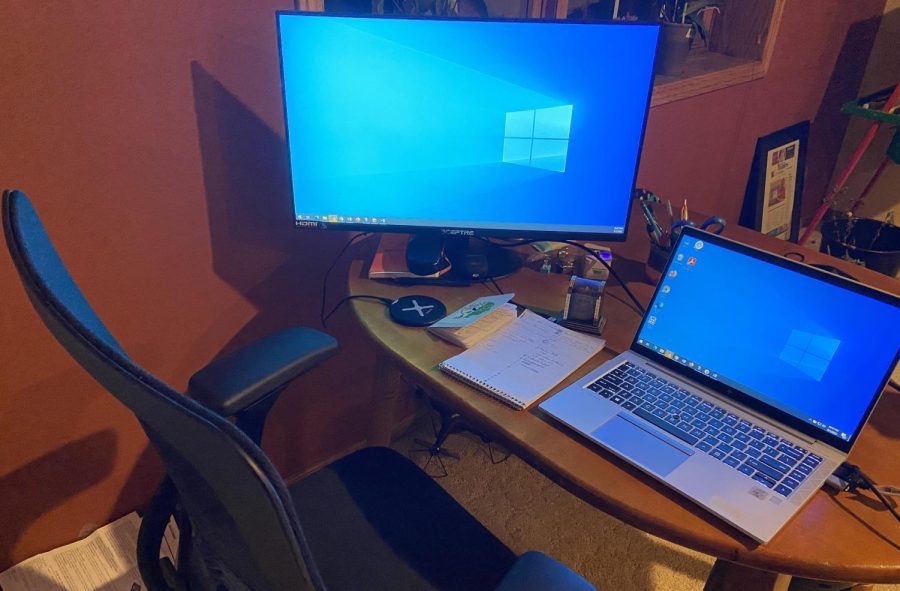COVID-19 has devastated the world in various ways, impacting the economy, job market, social atmosphere and political climate. Americans have had to adapt in ways never thought of before in an attempt to overcome this virus. But one thing forever altered by COVID is the way Americans work.
With cases inciting a national panic in late 2019 and early 2020, many companies had to alter their protocol for employees at work. Several large corporations transitioned into a work-from-home agenda to mitigate the spread of the virus. Schools sent their teachers home, though teaching heavily relies on forming in-person connections. Small businesses unable to sustain a profitable online-model were effectively shut down.
The work from home plan offered significant benefits for companies and employees who could complete a majority of their work online. Amid the comforts of their homes, 54% of employees who were sent to work remotely still do now that the crisis has diminished, according to Pew Research.
The other 46% has faced some difficulty attaining the same level of work at home as in their office. Academia, in particular, was severely disadvantaged with the work from home process. Chemistry teacher Elizabeth Moritz retailed her experiences while teaching from home. “[Working from home] was definitely more challenging just because most of my materials were here, my plans, and books and all the stuff I use. That made it a lot more challenging,” she said.
Moritz also credited household distractions to detract from the working experience. “Even though we have an office with a computer, the distractions are very difficult to get around,” she explained. “You have people calling the house or neighbor dogs barking or your pet pawing at the door because you will not let them into the computer room. So it was difficult to focus and I was not near as productive as I would be [in the classroom].”
A critical aspect of teaching is forming a real connection with students and inspiring a productive and engaging learning environment. The work from home situation withdrew such connections, making both teaching and learning extremely difficult. Moritz found this to be the largest detriment in the work from home experience. “The whole purpose was to communicate with your students from home, but you had that distance – it is just not the same,” she said. “You just weren’t making connections and I just didn’t get to know my students.”
Though academia suffered through the shift to online work, industries such as banking, finance, virtual healthcare and information technology have initiated a permanent shift towards remote work. Apple, Microsoft, Spotify, Facebook and Adobe are some big-name corporations switching to permanent work from home.
Though not as interaction-dependent as academia, these industries have faced some decrease in collaboration and creative thinking.
But employees of these industries have benefited from schedule flexibility, cost effectiveness and a better balance of family time. They save time and money otherwise spent on commuting and getting ready. Employees do not have to spend time throughout their day driving to work or money buying professional clothing, for example.
Employees no longer had a strict routine. French teacher Marina Boes recollected her experiences with remote work. “It was nice to be able to work when I wanted to and to have students work when they wanted to. It was nice to just have that time.”
But some necessitate a routine in their life to maintain stability and peace. Moritz depicted her experiences with this altered, flexible routine. “You didn’t have to spend a lot of time getting ready, you know like everyone else working from home, but it is kind of offset by the fact that now you are not in your routine and you are not taking time to take care of yourself as much,” she said.
Generally employees seemed less stressed while working remotely, but certainly some fields warrant a higher level of face to face, in-person communication making remote work difficult.
Primarily, the company profited from this shift, as immense costs. Corporations no longer had to support thousands of employees tangibly. Costs of utilities, facility, transportation or any material benefits were dropped, leading to substantial profit for companies in an otherwise struggling economy.
COVID incited a remote work period which forced millions of employees and corporations to adapt and transform their process of work. The shift to work-from-home was met with a myriad of positives and negatives, and will surely forever alter the way of work for Americans today.









